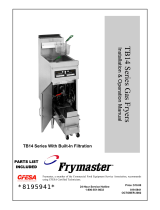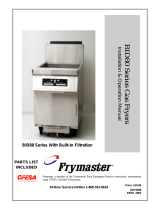
TRIATHLON SERIES GAS FRYERS
CHAPTER 3: INSTALLATION
3-3
3.3 Gas Connections (cont.)
C. Manual shut-off valve: This gas service supplier-installed valve must be installed in the gas
service line ahead of the fryers in the gas stream and in a position where it can be reached
quickly in the event of an emergency.
D. Regulating Gas Pressure: The fryer and shut-off valve must be disconnected from the gas
supply during any pressure testing of the system.
1. External gas regulators are not normally required on this fryer. A safety control valve
protects the fryer against pressure fluctuations. If the incoming pressure is in excess of
½" PSI (3.45 kPa/35 mbar), a step-down regulator will be required.
CAUTION
The fryer must be isolated from the gas supply piping system by closing its
individual manual shut-off valve during any pressure testing of the gas supply piping
system at pressures equal to or less than ½ PSI (3.45 kPa/35 mbar).
The fryer and its individual shut-off valve must be disconnected from the gas supply
piping system during any pressure testing of the gas supply system at test
pressures in excess of ½ PSI (3.45 kPa/35 mbar).
E. Manifold Pressure: Your local service technician should check the manifold pressure with a
manometer.
1. Check the rating plate for manifold gas pressures. Natural gas units require 3.5" W.C.
(8.71 mbar) and propane requires 10" W.C. (25 mbar).
2. When installing a pressure regulator, ensure the arrow forged into the bottom of the
regulator body is pointing downstream, towards the fryer. The air vent cap is also part
of the regulator and should not be removed.
3. If a vent line from the gas pressure regulator is used, it should be installed in
accordance with local codes or in the absence of local codes, with the National Fuel
Gas Code, ANSI Z223.1-(latest edition).
WARNING
Use a diluted soap solution to find potentially dangerous gas leaks when making
new connections.
F. Regulators can be adjusted in the field, but it is recommended that they not be tampered with
unless the part is known to be out of adjustment or serious pressure fluctuations are found to
exist and can be solved no other way.



























